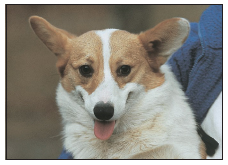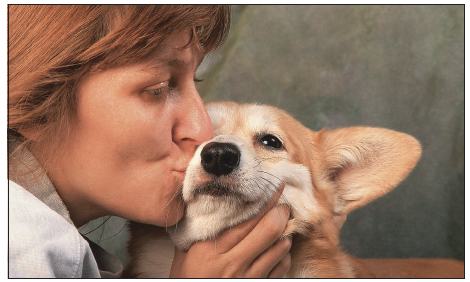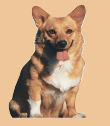

“Why the Pembroke?” you ask. Because they’re great little dogs! They are big dogs in small packages, fitting into most households with ease. As a companion, the Pembroke knows few equals. A great friend to children, he takes to babysitting like a duck to water. He is short enough to be a perfect child-sized companion, yet sturdy enough to enjoy a youngster’s hearty play.
For the adult, he’s active and game for anything on the day’s calendar. Sound and sprightly, he can go for a long walk at a brisk pace, content to be on leash. He will also happily enjoy off-leash runs in a secure area. He is agile enough to jump up into your car on his own, but small enough to fit in the smallest city apartment. Whether the family simply wants a pet for all to enjoy, or if someone wants a dog smart enough to be competitive in the obedience or agility rings, the Pembroke fits the bill.
All puppies are cute, but there is nothing quite so adorable as a Pembroke puppy. The breed standard of the American Kennel Club calls for “Outlook bold, but kindly. Expression intelligent and interested.” This description aptly tells of the breed’s alert and sensitive nature.

The adorable and expressive Pembroke—it’s easy to see why so many people fall in love with the breed!
The puppy Pembroke, with his bright, sparkling, inquisitive eyes and that characteristic foxy expression, seems to say, “Please, take me home!”
The Pembroke is an all-around dog, a jack of all trades. He wants to please those he loves and be in their company as much as possible, thriving on being with his special people. While he loves to lie about with his feet up, the Pembroke enjoys a challenge and is interested in all aspects of life. Pembrokes are amenable to training and can become precision workers as long as the trainer is clever enough to make each exercise new and continually interesting. The dog’s eager-to-please attitude, and the fact he enjoys being somewhat the class clown, makes him a show-off worker, seeming to say, “Hey, watch me!”
The Pembroke comes in a handy size. This big dog in the small package stands 10–12 inches at the shoulder but appears to be taller due to his fairly long neck and alert bearing. He weighs up to 30 lb for dogs, with bitches a little smaller, weighing up to 28 lb, making the Pembroke light enough for most adults to pick up and carry around without difficulty.
He is easy to keep too, requiring just the standard diet of quality dog food. Moreover, with that nice short coat, there is little grooming to be done. He requires a bath occasionally, along with regular grooming, brushing and combing to keep the loose hair in check, as well as nail trimming as needed.
The alert nature of the Pembroke makes him a reliable guardian of his home and family. He can be quite vocal at times and will let you know when someone is about to ring the doorbell. He also can engage in “sport” barking but, because of his great intelligence and willingness to please, he will quickly respond to your command to stop unnecessary barking.
LEAVE THE BREEDING TO THE EXPERTS
Your children do not need to witness the miracle of birth by breeding their beloved pet. This knowledge can be gained by trips to the library, from books and videotapes. There are too many unwanted puppies in the world right now and unless your Pembroke is of top show potential and been specifically placed with you for breeding purposes, it is best to leave the breeding of Pembrokes to knowledgeable, committed, responsible breeders.
The Pembroke, due to his inherent easy and steady disposition, fits into most family situations. It doesn’t take an overly dominant owner to become master of this dog. The Pembroke, like almost every breed, needs to be a full-fledged member of the household. He will do well with an owner who takes him for long daily walks, includes him on trips in the family car and watches television with him in the evenings. A working couple can also provide a good home for a Pembroke if, when they are at home, the dog is not left outside but is included, whenever possible, in the evening and weekend activities.
He generally does well with children of all ages, provided that he has been raised with them and that the youngsters are kind, gentle and considerate of the dog. Children and dogs naturally go together, but it is important that the child is aware the dog is a “person” in a fur coat, not a teddy bear or a doll.

The Pembroke is an affectionate family dog that adapts equally well to children and adults.
The household with someone home during the day is ideal for any dog, greatly facilitating socialization and house-training. But in these modern times when so many couples work, and children are off at school, some planning must be done to accommodate the puppy while he is left alone. No puppy should be left loose in a house; even closed into the kitchen or living room is not an ideal situation. A lonely puppy becomes a bored puppy and pretty soon damage is inflicted on his surroundings. This isn’t good for the furnishings, nor is it good for the puppy, as many of these items when chewed and swallowed cause great harm and big veterinary bills. You will want to learn all about the proper use of a crate as a tool for house-training, for safety and for providing structure for your dog.
All dogs in urban settings must have a fenced enclosure. No dog can be expected to stay within the confines of his own unfenced property or be allowed to run loose in a neighborhood. There are too many cars and trucks about, going too fast, to risk a dog’s being loose on the streets. That may have been possible when you were growing up, but it isn’t feasible anywhere nowadays!

It’s hard to resist a sweet, charming and undeniably huggable Pembroke.
PEMBROKE LIFESPAN
The average lifespan of a Pembroke is between 11 and 13 years, but some Pembrokes have been known to live as long as 18 to 20 years.
All walks must be on a leash and collar. Any time the Pembroke is off-leash, he must be far away from traffic, as his natural curiosity and his keen senses will cause him to throw caution to the wind and just keep going, with or without his owner. No dog wants to be locked away when the family is home. A Pembroke who is included whenever possible in family activities will be a happy, well-adjusted Pembroke.
The Pembroke is generally a healthy breed but, as with all dogs, pure-bred and mixed-breed alike, they do have some problems thought to be inherited and others that are sometimes influenced by environmental factors.
Great care should be given to keeping your Pembroke slim and trim, with just a nice layer of fat and muscle covering the ribs. Ideally he should look like a lean hard athlete, capable of doing the job for which he was bred.
Back problems in dogs are as common as they are in humans, and Pembrokes are known to suffer from them. There are many reasons for dogs to have back problems (extending from the thoracic vertebrae through the lumbar vertebrae to the coccygeal vertebrae region), including familial as well as environmental causes. Slipped disc is the most common of the diseases of the spine that affect some Pembroke lines, sometimes called protrusion of the intervertebral disc. Dogs with skeletal problems that affect their flexibility and movement should not be used for breeding.
Common symptoms of back problems can be a reluctance to go up and down stairs or in and out of your car, shivering, hiding, lack of appetite and, in the extreme, hunched posture or partial or complete paralysis of the hindquarters. Any and all symptoms require immediate attention from a veterinarian.
Eye diseases of varying types can occur in some Pembrokes. Cataracts and progressive retinal atrophy (PRA) are the most commonly mentioned. Both of these diseases are serious and can lead to blindness. Persistent pupillary membrane (PPM) is another eye disease occurring in some Pembrokes. PPM occurs when pieces of developmental membrane remain, varying from small spots to large connecting threads; however, the consequences are minor. A good question for any breeder is, “Have you encountered any inherited or congenital eye disease in your family of Pembrokes?” A good breeder will provide you with documentation of his stock’s being tested and free of problems.
A HEARING DOG
The intelligent, eager Pembroke is a natural at many jobs in the canine world. They have been used successfully as hearing dogs, assisting owners with diminished hearing or complete deafness. Easily trained, the Pembroke responds to the sound of an alarm clock in the morning by jumping on his owner’s bed, awakening his favorite person to begin his day. Another very useful job for the hearing dog is responding to the kettle’s whistle, letting his owner know that the water is boiling and ready.

Hip dysplasia, simply put, is a failure of the head of the femur to fit snugly into the acetabulum, with resulting degrees of lameness and faulty movement. The inheritance of the defect is polygenic, which means there is no simple answer to the elimination of the problem. Responsible breeders routinely x-ray their breeding stock and breed only from superior animals who have been graded in the categories deemed acceptable for breeding. While it is important that both the sire and dam have been x-rayed and cleared for breeding, it is just as important that the parents’ littermates, grandparents and so on have been x-rayed and their history known. Family selection is as important as individual selection.
In recent years, we have also learned through the evaluation of the hips of the achondroplastic (dwarf) breeds, such as the Dachshund, Basset Hound and both Corgis, that what constitutes acceptable healthy hips in these dwarf breeds is different from the more traditionally balanced, squarely built breeds such as the Doberman Pinscher, Airedale Terrier and Shetland Sheepdog. The hip status of the parents and the incidence of hip dysplasia in his line are important questions to ask any breeder of Pembrokes.
Urinary tract diseases have been found with some frequency in the Pembroke, specifically cystinuria, which is high levels of cystine found in the urine. This usually leads to bladder-stone formation and is more commonly found in males. Cystitis is a bacterial bladder infection found in the female as well as the male. There may be blood in the urine, and urination may be difficult and/or painful.